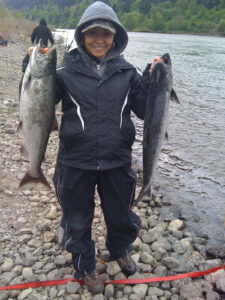Success in Salmon
A conservation with Columbia Land Trust board member Aja DeCoteau

DeCoteau’s mission at CRITFC is to ensure fisheries thrive for generations to come.
Aja DeCoteau, the newest member of Columbia Land Trust’s board of directors, recently sat down with the Land Trust’s Jay Kosa to discuss her story, her work, and her hopes for the Columbia River. A citizen of the Yakama Nation, DeCoteau grew up in Wapato, Washington, on the Yakama Indian Reservation. Her deep connection with the land drives her in her work at the Columbia River Inter-Tribal Fish Commission (CRITFC).
Can you tell me about CRITFC and your role with the organization?
The mission of CRITFC is to provide a unified voice in the management of the fishery resources and protect reserved treaty rights on behalf of our member tribes, which are the Nez Perce, Umatilla, Warm Springs, and Yakama tribes. As watershed department manager, I oversee an array of programs, including climate change, water quality, habitat protection and restoration, public relations, tribal workforce development, and inter-tribal coordination.
How do you think the missions of CRITFC and Columbia Land Trust align?
There’s a tremendous respect for the river, fish, and wildlife. We share the view that we are stewards of the land and that we have a responsibility to protect the river for future generations. Both organizations understand how vital relationships are. I hope that, as a board member, I can offer a tribal voice for the Land Trust, strengthen tribal relationships, and help build new ones.
What significance does the Klickitat hold for you?
Well, my daughter’s middle name is Klickitat. Also, my grandfather fished the Klickitat his whole life, and he fished Celilo Falls before it was inundated. I have great memories of sitting on a scaffold with him at Lyle Falls and watching the fish as he’d dip net. That’s one of the main reasons as to why I studied fisheries in college.
Describe salmon’s importance among the tribes of the Columbia River.
It starts with our creation story. A long time ago, the Creator was preparing the world for people. He called a grand council of animals and plants and asked them how they would help the people. The salmon was the first to offer its body for food. Then the deer and elk, followed by the roots and berries. At the center of all of this is water, upon which all life depends. These are our first foods, and we have a reciprocal relationship in that they nourish our people and we protect them and their habitats. For us, natural resources are cultural resources. Without salmon, our religion and our culture would be devastated.
How well do you think people in the region understand the Columbia River’s native history?
In the past, when I gave presentations, I realized there wasn’t a general understanding of tribal life on the river now, let alone before the construction of the dams. Tribal people have lived on this river for thousands of years. Knowing that history and passing down that knowledge is important for us. That’s why we do a lot of outreach, and it’s why we try and share personal stories. Now I start all of my presentations outlining the history of the river and provide an overview of treaty rights and tribal sovereignty.
Columbia Land Trust has been looking ahead 25 years as part of its conservation planning. What are your hopes for the Columbia River region a generation from now?
Professionally, we measure results in the number of fish. Wy-Kan-Ush-Mi Wa-Kish-Wit (Spirit of the Salmon) is CRITFC’s 25-year plan with the ultimate goal of seeing 4 million salmon making it over the Bonneville Dam. We’re halfway there now, so I see us striving forward over the next 25 years to ensure clean water and abundant fish. Personally, I want my children to have the resources available to continue their culture and traditions.